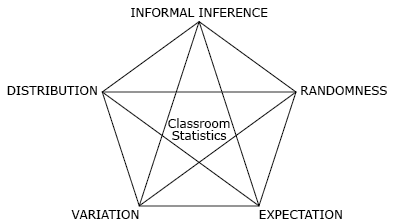Home > Statistics > Big ideas
Big ideas
Variation is the term that describes the differences we observe around us in every aspect of life, such as age, height, rainfall, temperature and prices. Variation is first mentioned in year 3 where students are asked to recognise variation in chance outcomes.
Expectation arises when we wish to harness variation and summarise data. For example,
- What is the typical price?
- What is the average temperature?
- What is the chance of tossing a head?
It arises throughout the curriculum but is referred to explicitly in year 6.
Distribution is the lens through which we look at variation, enabling us to identify and describe variation, and look for and confirm expectations. Distribution is the underlying concept for data representation at all levels of the curriculum.
Randomness describes a phenomenon in which the outcome of a single repetition is uncertain, but there is nonetheless a regular distribution of relative frequencies in a large number of repetitions. It is explicitly mentioned in year 8.
Informal inference is an evidence-based process balancing the variation and expectation found in sample data when answering a meaningful population-based question. It is implicit throughout the curriculum.
Variation
It is the variation in data that attracts our attention and prompts our questions. Without variation there would be no statistics!
Expectation
Expectation narrows the focus of data from its overall variation to a summary statistic, such as the arithmetic mean or most common value (mode), or to a theoretical value such as the probability of an event.
Distribution
Distribution provides the mechanism for studying variation and expectation by promoting visual representations of data.
Randomness
Randomness arises in processes that have unpredictable individual outcomes but that display patterns over the long term. The unpredictability creates variation and the pattern produces expectation.
Informal inference
Informal inference occurs when, from the evidence collected (perhaps heights of year 8 students in our class), we make a generalised claim (perhaps about the heights of year 8 students across Australia). We cannot be absolutely certain about our claim.

